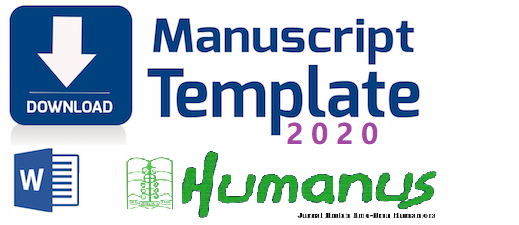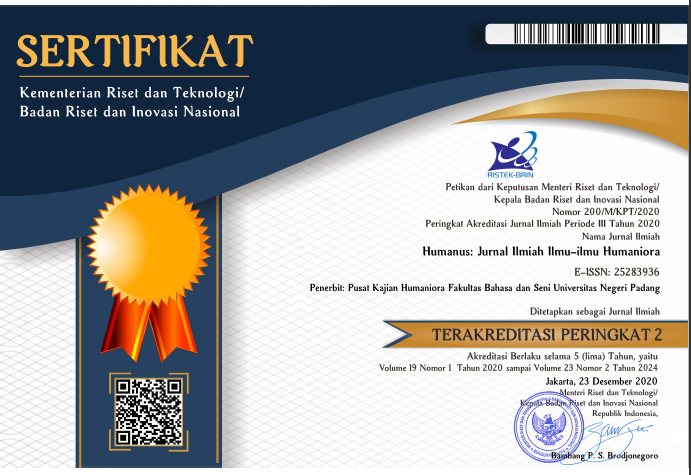SPACE AND TIME: ANALYZING COMIC PANELS ON KOMIKALISASI HUJAN BULAN JUNI
 ), Utami Dewi Pramesti(2), yulianti Rasyid(3),
), Utami Dewi Pramesti(2), yulianti Rasyid(3), (1)
(2) Universitas Negeri Padang
(3) Universitas Negeri Padang
 Corresponding Author
Corresponding Author
Copyright (c) 2018 Humanus
DOI : https://doi.org/10.24036/humanus.v17i2.8044
Full Text:
 Language : id
Language : id
Abstract
Hujan Bulan Juni is a short comic illustrated by Mansjur Darman. It is a modified form of literary works from poetry text into comic. Converting the written language into a visual language can provide different understanding and reading experience because the visual language uses its own distinct and interesting "language system" which appealing to study. For example, the use of comic element such as panel that communicate ideas or stories. The panel is a space-time element which described the dimension of space and time as the actual concept that we know of. The panel also creates the illusion of invisible elements such as sounds. This paper examines 1) the use of visual language, especially panel representation on time and space on Hujan Bulan Juni short comic; 2) the aesthetic and atmosphere created by comic panels. This paper use qualitative descriptive approach by conducting literature study with the help of data analyses table. Findings indicate the overall use of panels on comic Hujan Bulan Juni depicted monotonously so that the space and time that the reader perceived of the story happened in one place and on the same time. In addition, the panels used in the comic produce a calm and gentle atmosphere. This is evident from the constant use of panels with no variation as well as time and timing impression of slow paced storytelling.
Keyword: Hujan bulan juni, visual language, comic panels, atmosphere
MEMBACA RUANG-WAKTU (SPACE-TIME) PANEL KOMIKALISASI PUISI HUJAN BULAN JUNI
Abstrak
Komik Hujan Bulan Juni yang diilustrasikan oleh Mansjur Darman merupakan pengubahbentukan karya sastra berupa teks ke dalam media komik. Pengubahbentukan dari bahasa tulisan menjadi bahasa visual dapat memberikan pemahaman dan pengalaman membaca yang berbeda karena bahasa visual menggunakan “sistem bahasa” tersendiri yang kompleks dan menarik untuk diteliti. Sistem bahasa dalam komik dapat ditelusuri dari penggambaran panel dan imaji yang merupakan representasi ruang-waktu (space-time). Adapun tujuan penelitian adalah untuk 1) melihat bagaimana penggambaran bahasa visual komik (ruang dan waktu) pada panel komikalisasi Hujan Bulan Juni; 2) serta pengalaman estetis (atmosfer dan emosi) yang muncul dari penggunaan panel tersebut. Penelitian ini menggunakan penelitian kualitatif deskriptif dengan melakukan studi pustaka dengan bantuan tabel analisis data. Temuan dari penelitian ini yaitu secara keseluruhan penggunaan panel pada komikalisasi puisi “Hujan Bulan Juni” karya Sapardi Djokodamono yang diubah bentuk oleh komikus Mansjur Darman digambarkan secara monoton sehingga ruang dan waktu yang dipersepsi pembaca yaitu cerita terjadi pada satu tempat dan satu waktu yang sama. Selain itu, penggunaan panel komik menghasilkan atmosfer tenang dan lembut. Hal ini terlihat dari penggunaan panel yang konstan, tidak variatif, serta penggambaran waktu (time) dan timing yang berkesan lambat dan tidak tergesa-gesa.
Kata kunci: komik hujan bulan juni, bahasa visual, panel komik, atmosferKeywords
References
Ahmad, H., Maulana, B., & Zpalanzani, A. (2006). Histeria komikita: membedah komikita masa lalu, sekarang dan masa depan. Jakarta: Elex Media Komputindo.
Beineke, C. E. (2011). Towards a theory of comic book adaptation. Dissertations, Theses, and Student Research: Department of English, 51.
Caputo, T. (2003). Visual storytelling: the art and technique. New York: Watson_Guptill Publications.
Clarke, M.J. (2017). Fluidity of figure and space in Osamu Tezuka’s Ode to Kirihito. Journal of Graphic Novels and Comics. DOI: 10.1080/21504857.2016.1270222
Cohn, N. (2010). Extra! extra! semantics in comics!: the conceptual structure of Chicago Tribune advertisements. Journal of Pragmatics 42 (2010) 3138-3146.
Cohn, N. (2012). Comics, linguistics, and visual language: the past and future of a field. F.Bremlett (Ed.), Linguistics and The Study of Comics. New York: Palgrave MacMillan
Cohn, N. (2013). Navigating comics: an empirical and theoretical approach to strategies of reading comic page layouts. Front Psychol V.4
Cohn, N., Axner, J., Diercks, M., Yeh, R., & Pederson, K. (2017). The cultural pages of comics: cross-cultural variation in page layouts. Journal of Graphic Novels and Comics. DOI: 10.1080/21504857.2017.1413667
Cohn, N. (2018). In defense of a “grammar” in the visual language of comics. Journal of Pragmatics 127 (2018) 1-19.
D’Angelo, M & Cantoni, L. (2006). Comics: semiotic approaches. Encyclopedia of Language & Linguistics (Second Edition), pages 627-635.
Duncan, R & Mathew, J. S. (2009). The power of comics: history, form & culture. New York: The Continuum International Publishing Group Inc.
Duncan, R. (2000). Toward a theory of comic book communication. https://www.hsu.edu/ academicforum/1999-2000/
Eisner, W. (2000). Comics and sequential art. Florida: Poorhouse Press.
Faisal, D., Pramesti, U. D., & Rasyid, Y. (2017). Lingual to visual transformation of Hujan Bulan Juni. Advances in Social Science and Humanities Research (ASSEHR), 148. 186-190
Hassoun, D. (2013). Sequential outliers: the role of spoilers in comic book reading. Journal of Graphic Novels and Comics, 4:2, 346-358. DOI: 10.1080/21504857.2013.784202
Klaehn, J. (2015). Synergy and synthesis: an interview with comic book creator Benjamin Marra, Journal of Graphic Novels and Comic, 6:3, 284-292. DOI: 10.1080/ 21504857.2014.943413
McCloud, S. (1993). Understanding comics: the invisible art. New York: HarperCollins Publisher, Inc.
Perron, B. (2016). Wandering the panels, walking through media: zombies, comics, and the post-apocalyptic world. Journal of Graphic Novels and Comics, 7:3, 306-318. DOI: 10.1080/21504857.2016.1199465
Rowe, C. (2016). Dynamic drawings and dilated time: framing in comics and film. Journal of Graphic Novels and Comics. DOI: 10.1080/21504857.2016.1180541
Sabeti, S. (2014). The ‘strange alteration’ of Hamlet: comic books, adaptation and constructions of adolescent literacy. Changing English: Studies in Culture and Education, 21(2), 182-197. DOI: 10.1080/1358684X.2014.897047
 Article Metrics
Article Metrics
 Abstract Views : 965 times
Abstract Views : 965 times
 PDF Downloaded : 235 times
PDF Downloaded : 235 times
Refbacks
- There are currently no refbacks.
Copyright (c) 2018 Humanus

This work is licensed under a Creative Commons Attribution-NonCommercial 4.0 International License.










